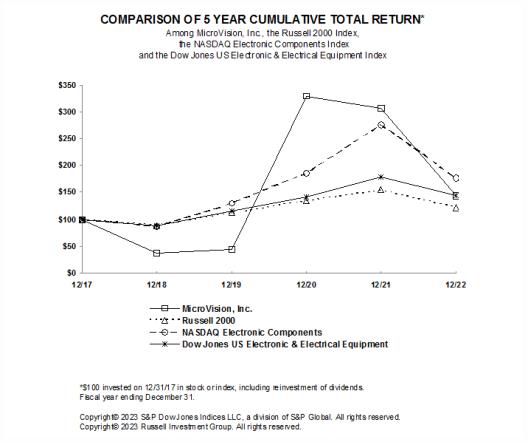PART I.
Preliminary Note Regarding Forward-Looking Statements
This Annual Report contains forward-looking statements, within the meaning of Section 27A of the Securities Act of 1933, as amended (the “Securities Act”), and Section 21E of the Securities Exchange Act of 1934, as amended (the “Exchange Act”), and is subject to the safe harbor created by those sections. Such statements may include, but are not limited to, projections of revenues, income or loss, capital expenditures, plans for product development and cooperative arrangements, acquisition activity and related integration efforts, technology development by third parties, future operations, financing needs or plans of MicroVision, Inc. (“we,” “our,” or “us”), as well as assumptions relating to the foregoing. The words “anticipate,” “could,” ”would,” “believe,” “estimate,” “expect,” “goal,” “may,” “plan,” “project,” “will,” and similar expressions identify forward-looking statements. Factors that could cause actual results to differ materially from those projected in our forward-looking statements include risk factors identified below in Item 1A.
Overview
MicroVision is a global developer of lidar hardware and software solutions focused primarily on automotive lidar and advanced driver-assistance systems (ADAS) markets where we can deliver safe mobility at the speed of life. We develop a suite of light detection and ranging, or lidar, sensors and perception and validation software to the automotive market for ADAS and autonomous vehicle (AV) applications, as well as to complementary markets for non-automotive applications including industrial, robotics and smart infrastructure. Our long history of developing and commercializing the core components of our lidar hardware and related software, combined with the experience of the team we recently acquired from Ibeo Automotive Systems (Ibeo) with automotive-grade qualification, provides a potentially compelling advantage over the less-experienced recent entrants into this market.
Founded in 1993, MicroVision, Inc. is a pioneer in laser beam scanning, or LBS, technology, which is based on our patented expertise in micro-electromechanical systems, or MEMS, laser diodes, opto-mechanics, electronics, algorithms and software and how those elements are packaged into a small form factor. Throughout our history, we have combined our proprietary technology with our development expertise to create innovative solutions to address existing and emerging market needs, such as augmented reality microdisplay engines; interactive display modules; consumer lidar components; and, most recently, automotive lidar sensors and software solutions for the automotive market.
On January 31, 2023, we completed the acquisition of certain assets of Ibeo Automotive Systems GmbH, which was founded in 1998 as a lidar hardware and software provider. Ibeo developed and launched the first lidar sensor to be automotive qualified for serial production with a Tier 1 automotive supplier and that is currently available in passenger cars by premium OEMs. Ibeo developed software solutions, including perception and validation software, which are also used by premium OEMs. In addition, Ibeo sold its products for non-automotive uses such as industrial, smart infrastructure and robotics applications.
For the automotive market, our integrated solution combines our MEMS-based dynamic-range lidar sensor and perception software, to be integrated on our custom ASIC, targeted for sale to premium automotive OEMs and Tier 1 automotive suppliers. We believe that our MEMS-based lidar sensor, or MAVIN sensor, and perception software demonstrates best-in-class features and performance that exceed market expectations and outperform competitive products. Our ADAS solution is intended to leverage edge computing and custom ASICs to enable our hardware and perception software to be integrated into an OEM’s ADAS stack.
In addition to our dynamic-range and long-range MAVIN sensor and perception software solution for the automotive market, our product suite includes short- and mid-range lidar sensors, both MEMS-based and flash-based, for automotive and industrial applications, including smart infrastructure, robotics, and other commercial segments. Also, our validation software tool is used by OEMs and other customers including Tier 1s for validating vehicle sensors for ADAS and AV applications. The tool includes software that automates the manual data classification or annotation process, significantly reducing the time and resources required by OEMs to validate their ADAS and AV systems.
In the recent past, we developed micro-display concepts and designs for use in head-mounted augmented reality, or AR, headsets and developed a 1440i MEMS module supporting AR headsets. We also developed an interactive display solution targeted at the smart speakers market and a small consumer lidar sensor for use indoors with smart home systems.
1

